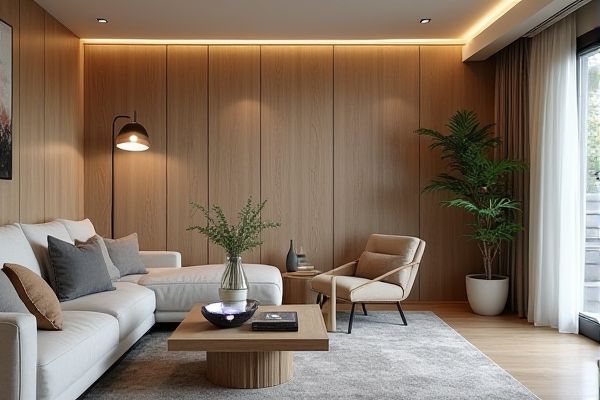
Double slatwall offers increased durability and load-bearing capacity compared to traditional slatwall, making it ideal for heavier merchandise or high-traffic retail environments. Explore the rest of the article to discover which slatwall option best fits your display needs and budget.
Table of Comparison
| Feature | Double Slatwall | Traditional Slatwall |
|---|---|---|
| Material Thickness | Thicker panels for enhanced durability | Standard thickness, less robust |
| Load Capacity | Higher weight bearing capacity | Moderate load support |
| Installation | More complex, requires stronger support | Easy installation on standard walls |
| Applications | Ideal for heavy or bulky merchandise | Suitable for light to medium displays |
| Cost | Higher initial investment | More economical |
| Durability | Long-lasting with resistance to wear | Less resistant, potential for faster wear |
| Customization | Limited but sturdy options | Wide variety of colors and finishes |
Introduction to Slatwall Systems
Double slatwall systems provide enhanced durability and increased load capacity compared to traditional single-row slatwall, making them ideal for heavier merchandise and more demanding retail environments. Traditional slatwall features single horizontal grooves that accommodate standard accessories, but double slatwall incorporates two parallel slots in each groove, allowing for greater flexibility in fixture placement and improved merchandising options. If your retail space requires efficient use of wall area and versatile display solutions, double slatwall offers significant advantages over conventional slatwall systems.
What is Double Slatwall?
Double slatwall consists of two layers of slatwall panels installed back-to-back, providing enhanced durability and load-bearing capacity compared to traditional single-layer slatwall. This design offers increased strength for heavier merchandise and improved stability, making it ideal for retail environments requiring robust display solutions. Your store fixtures can benefit from double slatwall's thicker construction and superior support for larger or more frequent product changes.
What is Traditional Slatwall?
Traditional slatwall consists of horizontal panels made from MDF or wood with evenly spaced grooves designed to hold hooks, shelves, and brackets for versatile retail or storage displays. Its standard single-layer design offers a durable surface for organizing products, making it ideal for straightforward merchandising needs. You can easily customize traditional slatwall with various accessories to optimize space and enhance product visibility.
Material Differences Between Double and Traditional Slatwall
Double slatwall panels are typically constructed with two layers of high-density MDF or plywood, offering increased strength and durability compared to traditional single-layer slatwall. Traditional slatwall often uses a single sheet of MDF with grooves cut into the surface, which may be less resistant to heavy loads and frequent impacts. Your choice between double and traditional slatwall should consider the material composition and intended use, as double slatwall provides superior support for heavier merchandise and enhanced longevity.
Installation Process: Double vs Traditional Slatwall
Double slatwall requires a more complex installation process due to its dual-layer design, which enhances strength and durability while necessitating precise alignment and additional anchoring for secure mounting. Traditional slatwall offers a simpler and faster installation, typically involving a single-layer panel mounted directly to the wall studs with standard fasteners. The choice between double and traditional slatwall installations depends on the desired load capacity and installation time constraints.
Weight Capacity and Durability Comparison
Double slatwall offers significantly higher weight capacity and enhanced durability compared to traditional slatwall, supporting heavier merchandise without warping or damage. Constructed with reinforced materials and additional layers, double slatwall withstands daily wear and tear more effectively, prolonging its lifespan in commercial settings. Your choice of double slatwall ensures reliable support for heavy items and reduces maintenance costs associated with frequent repairs or replacements.
Flexibility and Customization Options
Double slatwall systems offer increased flexibility and customization options compared to traditional slatwall by providing two layers of slats that allow for more versatile fixture placement and spacing. This design supports a wider variety of accessories, hooks, and shelves, enhancing the ability to tailor displays to specific merchandising needs. Retailers benefit from double slatwall's modular nature, which maximizes wall space and accommodates frequent layout changes more efficiently than traditional single-layer slatwall panels.
Cost Analysis: Double Slatwall vs Traditional Slatwall
Double slatwall typically incurs higher upfront costs than traditional slatwall due to its increased material use and enhanced durability features. Traditional slatwall offers a more budget-friendly option for standard retail displays but may require more frequent maintenance or replacement. Cost analysis reveals double slatwall's investment can yield long-term savings through reduced repair expenses and improved load-bearing capacity.
Aesthetic Impact in Retail and Commercial Spaces
Double slatwall offers a more visually dynamic and modern aesthetic compared to traditional single-layer slatwall, creating depth and dimension that enhances product displays in retail and commercial spaces. The layered design allows for customized lighting effects and varied attachment points, making your merchandise stand out more effectively. This upgraded look can elevate the overall shopping experience, attracting customers and encouraging longer browsing times.
Choosing the Right Slatwall System for Your Needs
Double slatwall systems offer enhanced durability and increased load-bearing capacity compared to traditional single slatwall panels, making them ideal for heavy or high-traffic retail environments. Traditional slatwall is more cost-effective and suitable for lighter displays, providing flexibility and ease of installation in smaller spaces. Selecting the right slatwall depends on evaluating display weight requirements, space constraints, and budget priorities to ensure optimal functionality and aesthetic appeal.
 homyna.com
homyna.com